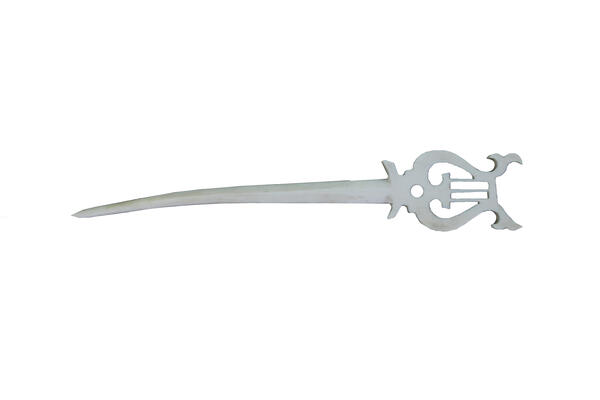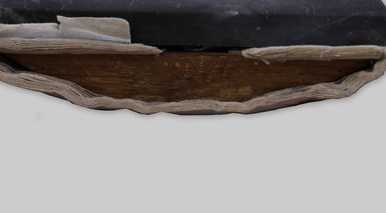A utility knife is a special tool that came into use in the XVIII–XIX centuries as an element of a writing set. It was a clumsy double-edged knife, often richly decorated. Such knives were made of not very strong steel, non-ferrous or precious metals, bone, stone. Designed primarily for cutting papers such as envelopes or book pages.
Previously, a new book bought in a store could not be opened without a book knife, since there was no hydraulic press that could cut through the thickness of the book pages. Therefore, a large sheet folded several times, containing up to 20 pages of the upcoming book, was simply stitched and joined to others — this is how the book was compiled, which immediately was taken for binding without cutting. It was impossible to flip the pages of such a book without first cutting it — the buyer brought the book home and cut the folds, separating the pages from each another.
The utility knife was irreplaceable both in the homes of Yeniseysk residents and employees of the Yeniseysk post and Telegraph office, organised in Yeniseysk in 1886 by connecting the post office and the Telegraph station.
A modern utility knife is a versatile small-sized tool, usually plastic, with a retractable replaceable metal blade. The main advantage of such a tool is that it does not need to be sharpened — during production, notches are applied to the blade, so that later you can easily break off a blunt segment. By the way, not everyone knows how to do this conveniently and safely. There is a lid on the handle of the knife that needs to be removed. It has a special slot in which the segment is placed and bent along the line from yourself.
The utility knife is used in absolutely different areas of household chores, for example, during repairs, in needlework, when working with various types of paper. At the same time, a modern utility knife has long gone beyond the utilitarian framework — it can act as an object of arts and crafts and sometimes a very refined or expensive business souvenir made of valuable materials. In addition, it can be connected to a fountain pen, ruler, and other office tools.
Previously, a new book bought in a store could not be opened without a book knife, since there was no hydraulic press that could cut through the thickness of the book pages. Therefore, a large sheet folded several times, containing up to 20 pages of the upcoming book, was simply stitched and joined to others — this is how the book was compiled, which immediately was taken for binding without cutting. It was impossible to flip the pages of such a book without first cutting it — the buyer brought the book home and cut the folds, separating the pages from each another.
The utility knife was irreplaceable both in the homes of Yeniseysk residents and employees of the Yeniseysk post and Telegraph office, organised in Yeniseysk in 1886 by connecting the post office and the Telegraph station.
A modern utility knife is a versatile small-sized tool, usually plastic, with a retractable replaceable metal blade. The main advantage of such a tool is that it does not need to be sharpened — during production, notches are applied to the blade, so that later you can easily break off a blunt segment. By the way, not everyone knows how to do this conveniently and safely. There is a lid on the handle of the knife that needs to be removed. It has a special slot in which the segment is placed and bent along the line from yourself.
The utility knife is used in absolutely different areas of household chores, for example, during repairs, in needlework, when working with various types of paper. At the same time, a modern utility knife has long gone beyond the utilitarian framework — it can act as an object of arts and crafts and sometimes a very refined or expensive business souvenir made of valuable materials. In addition, it can be connected to a fountain pen, ruler, and other office tools.



